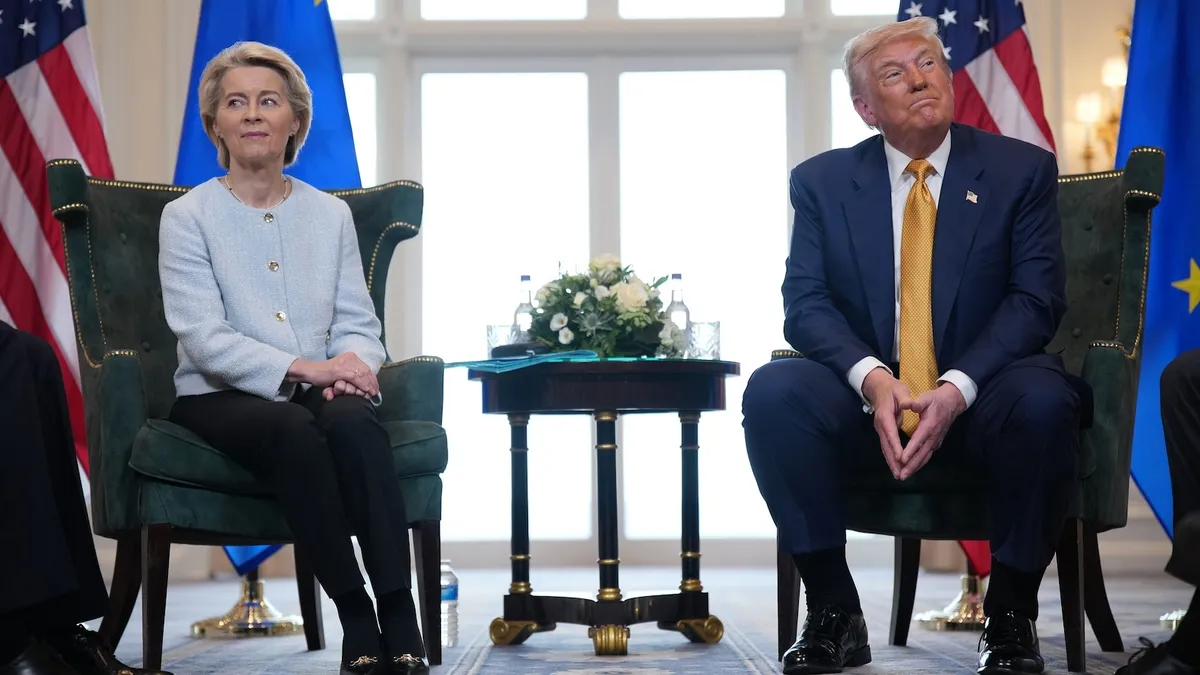
On Sunday, President Donald Trump announced a significant trade agreement with the European Union, marking the latest in a series of international accords as the White House prepares to impose tariffs on multiple countries this week. Before this agreement, the European Union was facing a daunting potential tariff rate of 30% that was scheduled to take effect on August 1. However, the new deal reduces the tariff on European products to 15%, a strategic move that aims to foster better trade relations with one of the U.S.'s largest trading partners.
In exchange for the lowered tariff rate, the European Union committed to purchasing $750 billion in energy-related goods over the next three years and investing an additional $600 billion in the United States. President Trump hailed the deal as the “biggest deal ever made” during his remarks to reporters on Sunday. Although the White House has yet to disclose the complete details of the agreement, European Commission President Ursula von der Leyen emphasized that it “creates certainty in uncertain times,” providing much-needed stability and predictability for citizens and businesses on both sides of the Atlantic.
The newly established trade agreement effectively lowers the tariff rate on European products to 15%. This is a significant reduction from the previously threatened 30% rate, though it remains higher than the standard 10% rate applied to most imports. The 15% tariffs on European goods align with the tariff levels set for Japanese products in a separate agreement reached last week. Comparatively, the U.S. tariffs on Vietnamese products are set at 20%, while Chinese goods currently face a steep 30% tariff.
Notably, the agreement includes exemptions for specific categories such as aircraft, semiconductor equipment, and certain chemical and agricultural goods, according to von der Leyen. Data from the Office of the U.S. Trade Representative indicates that the European Union purchased approximately $370 billion worth of U.S. products in 2024. In contrast, the U.S. imported about $605 billion in goods from Japan. Furthermore, the U.S. goods trade deficit with the EU ballooned to $235.6 billion last year, representing a nearly 13% increase from 2023, highlighting the critical nature of these trade negotiations.
Experts anticipate that the trade agreement may lead to price increases in certain sectors, particularly pharmaceuticals and beverages. Jason Miller, a professor of supply chain management at Michigan State University, indicated that pharmaceuticals account for roughly a quarter of U.S. imports from the EU. He explained that while European beverage producers have generally absorbed the costs of tariffs thus far, the new elevated tariff rate will likely compel them to transfer some of these costs to consumers. “Prices will go up a little bit -- nothing too pronounced,” Miller stated, acknowledging the typical economic principle that tariffs generally lead to increased prices for consumers.
As the August 1 deadline approaches, President Trump has successfully negotiated trade agreements with various countries, including the United Kingdom, Indonesia, Vietnam, the Philippines, Japan, and now the European Union. The White House has also reached a preliminary accord with China that aims to mitigate previously imposed tit-for-tat tariffs between the two largest economies in the world. However, on Friday, additional tariffs are set to be enacted on several major trading partners, including Canada, Mexico, South Korea, and Brazil.
President Trump has maintained that these tariffs are a crucial element of his negotiation strategy, aiming to secure the best possible deals for the American people and workers. White House press secretary Karoline Leavitt reiterated this sentiment last month, emphasizing the importance of the August 1 deadline. When asked if there could be an extension to this deadline, Trump decisively remarked, “No. August 1 is there for everyone,” indicating that the new trade agreements are set to commence on that date.